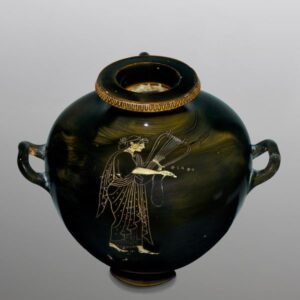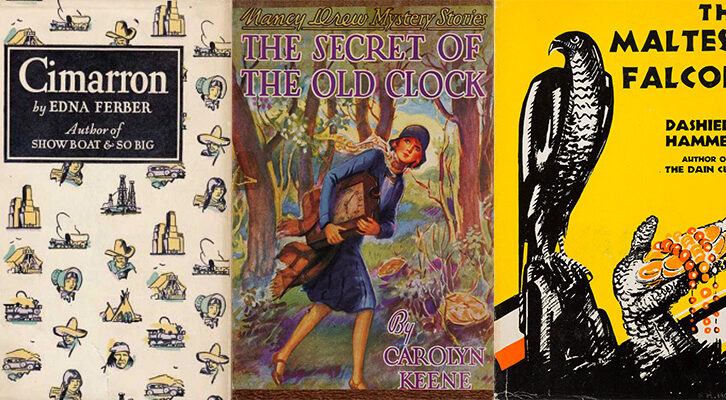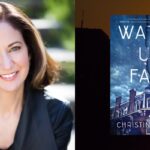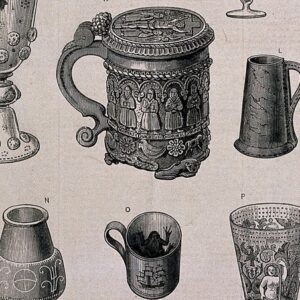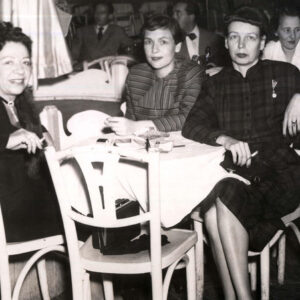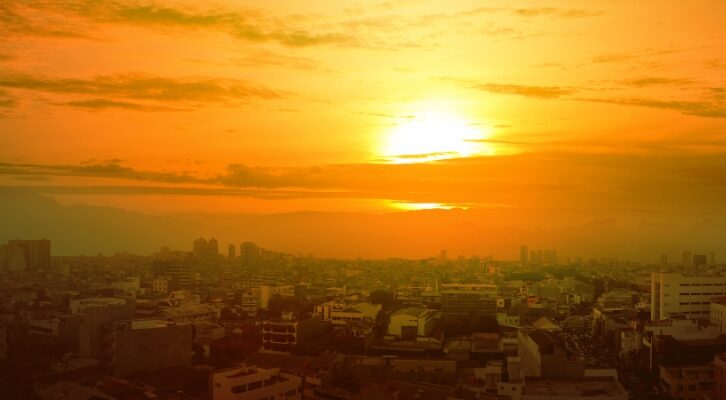
Dreading Those Sunny Days: The Perils of Surviving Without Shade as a Homeless Person
Sam Bloch Shines Light on How Sun Relief as an Economic Resource in the Era of Capitalism and Climate Change
Debbie woke up and peeled herself off an imitation leather interior. A rail-thin woman with an infectious smile, the sixty-six-year-old retired schoolteacher became homeless in 2017. After she lost her childhood home in Compton, she laid her head down in women’s shelters, first for a spell in San Francisco before returning to South Los Angeles. In 2020, when the Covid-19 pandemic hit, she caught the virus and the shelters kicked her out.
Where was she supposed to go? She had already exhausted her savings at a Motel 6 and could not ask her family to put her up. So like many Angelenos down on their luck, she started sleeping in the back seat of her car, a beat-up Mercedes-Benz sedan with a fickle ignition.
Debbie used to love sunny days, but she dreaded them when she became unhoused. A daily search for a place to beat the heat became harder when libraries closed during the pandemic, which deprived her of free air-conditioning. Cars are decent shelters from the rain, but the glass windows and dashboard make them cauldrons in the sun. The suffocating Benz pushed the lifelong asthmatic to the edge. To survive the heat of South L.A. streets, she needed shade.
And for a time, she had it. Debbie summered under the thick crown of a majestic ficus at the Watts Civic Center, but when the towering botanical structure was felled for urban development, she had to get out of the sun. And in April 2021, when I met her, she was still searching for shade. At one point, she parked overnight in a gated lot that a local nonprofit reserved for Angelenos like her, who lived in their cars.
Besides a few rows of swaying palms, there wasn’t much cover, yet the conditions were tolerable, in part because Debbie was somewhere else in the light of day. She had become a community organizer for TreePeople, a stalwart environmental group that planted trees in Watts, a neighborhood where she had familial roots. Trees fight the heat that worsened her life on the streets and even put it at risk. She moved up to the driver’s seat and turned over the ignition.
Debbie used to love sunny days, but she dreaded them when she became unhoused.
“When I talk about the heat in Watts, I really know all about it,” she explained. “Because I can’t do anything to escape it.”
*
You can see L.A.’s shady divide from outer space. On one side of the sprawling city are wealthy enclaves built around golf courses and tucked into leafy canyons. Mansions nestle under the canopies of majestic oaks and sycamores, and shoppers stroll beneath their manicured crowns.
On the other side are neighborhoods where vast concrete expanses are open to the sun: playgrounds, parking lots, bare sidewalks, and wide roads. Bus riders bake on unsheltered streets and homeless people seek refuge under highway overpasses. Some came to L.A. to seek their sunny American dream only to suffer relentless heat.
Why do L.A.’s wealthy neighborhoods have ample shade and poor neighborhoods have hardly any at all? One reason is the technical challenge of growing trees in a semiarid city built for cars. Another is the political challenge of mustering support for shade’s maintenance and provision.
And then there are the hostile attitudes about public space. For decades, L.A. police have discouraged trees because their shade is a magnet for gathering and their umbrage interferes with surveillance.
And more recently, in the throes of a homeless crisis, city staff and law enforcement have removed and denuded trees to control the conditions on the street. As temperatures rise, these social and cultural forces that conspire against shade make it difficult for Debbie and other Angelenos to cool down.
Los Angeles has a longstanding reputation as a warm-weather paradise. Since the nineteenth century, new arrivals have flocked there to chase the sun. The light was believed to be the cure for tuberculosis, a miraculous ingredient to ensure healthful longevity, and later, what turned celluloid reels into movie magic.
Sunshine is still the icon of the California lifestyle, drawing us to the beach or the pool to tan, and to cruise Sunset Boulevard with the top down, past the skinny silhouettes of ubiquitous palms. The distaste for shade may originate in solar worship, but it manifests in cultural obsessions like Hollywood noir, in which long shadows and unlit corners represent the criminal underworld.
Shade is not part of L.A.’s modern identity. In the 1930s, the city was rezoned to Federal Housing Administration design standards and banned high-density developments like row houses. Although apartments were once common, city leaders bowed to a prevailing wisdom that L.A. should not resemble a dark and cramped East Coast city. Freestanding single-family homes that were touched by sun on every side became mandatory.
In came the cars. L.A.’s curbside trees were removed to accommodate shrinking sidewalks and expanding roads, and new rules that required parking minimums dealt another blow to the urban forest. Mediterranean-style courtyards became endangered species as the shaded commons were converted to outdoor car storage.
For decades, no building could be taller than the twenty-seven- story city hall, and even after business elites successfully convinced the city to raise height limits, towers were only allowed in small pockets. “And already their shadows fall in checkered and criss-crossed pat- terns across the speckled sun-kissed streets of our city,” city officials noted in 1959, somewhat ruefully. “The face of Los Angeles is changed and it is lifted with the cosmetics of steel and mortar.”
Since the 1970s, an individual right to sunshine has been practically enshrined in state law. Many construction projects fall under the California Environmental Quality Act, a regulation designed for public works that morphed into a tool to thwart unwanted development. Until 2019, L.A. planners required a shadow analysis of any building that loomed five stories over the surrounding landscape, fearing the hundred-foot shadows that could darken nearby gardens and sunbath- ing decks.
Even today, amidst a housing crisis that has pushed tens of thousands of Angelenos like Debbie onto the streets, city councillors in the San Fernando Valley try to veto new apartment complexes in part because of their shadows. NIMBYs everywhere are quick to complain when their views are blocked, but in California, environmentalists have gone further with the Solar Rights and Solar Shade Control Acts, which protect homeowners from shadows falling on their solar panels.
The law even goes so far as to define circumstances in which they can trim their neighbors’ trees. In L.A., people have a legal right to sunshine; as for shade, they are on their own.
Given Angelenos’ sun obsession, it may come as a surprise that they were once appreciative of shadows. In the eighteenth century, Spanish colonists discovered a cool and lush landscape managed by the native Tongva people in the village that became modern downtown. Such villages were located near the fertile banks of the Los Angeles River, some under great forests of oak trees, sycamores, and willows.
After taking the land, the Spanish cleared these woods for arcaded missions and whitewashed adobes oriented away from the sun to keep their occupants cool. The Anglo settlers who arrived in the nineteenth century planted new trees to offset those the Spanish cut down.
To compensate for the dry climate, California farmers built a world-renowned system of canals to cultivate citrus orchards. Then the construction of the Los Angeles Aqueduct brought millions of acre-feet of water into the region, triggering a profound ecological change.
Naturally bare hillsides and grasslands became dense urban woodlands, and gardens and fruit trees bloomed in backyards across the city. All that moisture cooled the air, and over a fifty-year period, L.A.’s summer highs dropped about a half degree every decade.
The bungalow—a single-story, shoebox-shaped house with over- hanging eaves inspired by the architecture of Indian hill stations— became popular with a middle class trying to stay cool. “They were actually prefabricated in factories,” said the late Mike Davis, the celebrated scholar of Los Angeles.
Tens of thousands of bungalows, many along the Alameda Corridor that runs through South L.A., were manufactured by Pacific Ready-Cut Homes, which advertised itself as the Henry Ford of home construction. Davis, who was briefly a Pasadena urban design commissioner, explained that shade used to be integrally incorporated into the Southern California streetscape.
The farm town where he grew up once had its own porticoes, in the form of large storefront awnings hoisted over the sidewalks. Arguably, until the 1930s, Angelenos’ relationship to the sun was equally one of avoidance.
All that changed with the arrival of cheap electricity. In 1936, the Los Angeles Bureau of Power and Light completed a 266-mile high- voltage transmission line from the Hoover Dam, supplying seventy percent of the city’s power at low cost. Southern Californians bought mass-produced ranch houses with air-conditioning. Shade was outmoded.
By the end of World War II there were nearly four million Angelenos in the county, many housed in new neighborhoods organized around driveways and parking lots. Parts of the city became “virtually treeless deserts,” Davis said.
And as the old farms and orchards were paved under buildings and roads, the air began to warm. Between 1940 and 1990, average and maximum temperatures in downtown L.A. rose about a degree every decade, outpacing other California cities.
Look at what happened to Pershing Square, once a glamorous five-acre park in the heart of the city. In the defining 1910 design, brick-lined paths carved through a dense urban wood. Under the tropical leaves of banana trees and birds-of-paradise, a white-collar lunchtime crowd read newspapers and books from a library cart and congregated to hold forth on global affairs.
Then in 1951, the park was bulldozed to install a three-story underground parking garage. The trees were relocated to Disneyland, where the ficuses shaded Main Street, U.S.A., and the date palms became scenery for the Jungle Cruise. On top of the parking garage, Pershing Square became a large and thin expanse of grass, as the subsurface made it impossible to plant deep-rooted trees.
To make things worse, the square was fenced off from the promenaders and flâneurs. The park’s “nuts” and “blabbers,” in the words of the Los Angeles Times, were relegated to its edges, where they competed for space with cars entering the garage through deep surface gashes.
It’s easy to see how this hostile design reflected the values of the peak automobile era, but there is more than meets the eye. The destruction of urban refuge was part of a long-term strategy to discourage gay cruising, drug use, and other shady activities downtown.
In 1964, business owners sponsored another redesign that was intended to finally clear out the “rude panhandlers, deviates and criminals.” The city removed the perimeter benches and culled even more palms and shade trees, so that office workers and shoppers could move through the park without being “accosted by derelicts and ‘bums.'” Sunlight was weaponized against these undesirables.
“Before long, pedestrians will be walking through, instead of avoiding, Pershing Square,” the Times declared. “And that is why parks are built.”
But it turned out to be an indiscriminate attack. Shorn of its canopy and surrounded by car traffic, the “see-through” Pershing Square was forsaken not only by scofflaws and degenerates but by shoppers and businessmen, too. It was not so much a dangerous place as it was ignoble, “a sort of last resort for people sleeping off the night before or dozing off the rest of their lives.”
As Times columnist Art Seidenbaum moaned, “Out went sweet shade. In came sterility.” The park was abandoned and fell into disrepair.
Yet to a certain kind of politician, the failure of Pershing Square looked like a success. Pershing Square set a template for Los Angeles, whereby a park is not mainly a place to gather and cool down but a revenue-generating asset.
The design of the pergola reflects the tension in Los Angeles.
Five blocks north of the square sits Grand Park, a rectangular, twelve-acre lawn opened to cater to the downtown’s growing residential population. At the opening in 2012, five thousand visitors stood in a freshly landscaped field to watch aerial dancers cascade down the face of city hall, the de facto stage across the street. Movie screenings and concerts are held regularly, and the park rakes in about $1.5 million annually, mostly in rental fees.
Like Pershing Square, Grand Park offers scant respite from the sun. It’s also built above a parking garage, which leaves no room for underground tree roots, nor for structural footings for a permanent shade structure. “They like the events, they like the lawn, they like being there,” said landscape architect Mia Lehrer. “But they find it very hot.”
In 2016, her firm submitted a winning design for a new park across the street, First and Broadway Civic Center Park, that was informed by critiques of Grand. In public workshops, the city officials who selected her design “heard it loud and clear from people that they wanted shade,” Lehrer recalled. The design by Studio-MLA and OMA calls for twenty-six-foot-tall metal structures that resemble California pop- pies, shading a split-level amphitheater and outdoor restaurant. It remains unbuilt.
Meanwhile, a new renovation of Pershing Square broke ground in 2023. Like previous efforts, it kicked off with a design competition sponsored by the square’s surrounding property owners. The winning proposal, by a French firm called Agence Ter, centers on a great lawn with plenty of space for public events. The design also calls for a massive, block-length arbor that the firm calls a “shade pergola.”
The thin slats of this public canopy will be hoisted thirty feet in the air by clusters of slender columns that expand like tree branches as they extend upward. The whole structure will be scaled by climbing vines, echoing a more natural tree grove that will be planted on the other side of the park. In renderings, the pergola seems to recede into foliage, and crowds mingle underneath in raking light.
But conspicuously, there are no benches. I asked landscape designer Lauren Hamer, then with Agence Ter, about that. Shade creates shelter, she said. “And Los Angeles obviously has a very conflicted position towards creating shelter in the public realm,” which is reflected in laws that antagonize the homeless. “Public spaces need to be open, so that people can move across them, as opposed to gathering there.”
She cited a failed 1986 proposal by James Wines which would have transformed the park into a miniature of the city itself—a “magic carpet” of different microclimates, each module locked in a grid. Although Wines won an open design competition, his park was never funded or built. Hamer thinks that’s because his version of the park was too inviting.
This expectation that Pershing Square not be too social—that it shouldn’t be a good place to hang out, as Hamer put it—was strange to the team at Agence Ter. “It’s exactly opposite the design traditions that we, as a French firm, know and are used to working with,” said architect Annelies De Nijs. “For us, parks are mainly places that are a destination,” she continued, where the public comes for a visit and then lingers.
The design of the pergola reflects the tension in Los Angeles. De Nijs said the firm mitigated the contested element of public comfort by designing a giant canopy that was “very high and very wide, so it becomes like one big overall ceiling,” rather than several smaller and more intimate “shade elements” that unwanted people, like the homeless, might seek to inhabit.
Eventually, when the pergola is completed, it will shade a section of Pershing Square in a dimmer and dreamier light. But it will not offer people like Debbie relief from the heat.
_______________________________

From the book Shade: The Promise of a Forgotten Natural Resource by Sam Bloch. Copyright © 2025 by Samuel Kahn Bloch. Published by Random house, an imprint and division of Penguin Random House LLC. All rights reserved.
Sam Bloch
Sam Bloch is an environmental journalist. Previously a staff writer at The Counter, he has written for L.A. Weekly, Places Journal, Slate, The New York Times, CityLab, and Landscape Architecture Magazine, among others. He is the author of Shade: The Promise of a Forgotten Natural Resource. Bloch is a graduate of the Columbia Journalism School, and a former MIT Knight Science Journalism Fellow and Emerson Collective Fellow. He is based in New York City.









